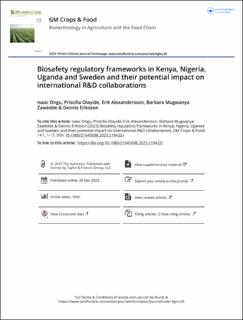| dc.contributor.author | Ongu, Isaac | |
| dc.contributor.author | Olayide, Priscilla | |
| dc.contributor.author | Alexandersson, Erik | |
| dc.contributor.author | Mugwanya Zawedde, Barbara | |
| dc.contributor.author | Eriksson, Ulf Dennis | |
| dc.coverage.spatial | Kenya, Nigeria, Uganda,Sweden | en_US |
| dc.date.accessioned | 2024-03-11T09:24:54Z | |
| dc.date.available | 2024-03-11T09:24:54Z | |
| dc.date.created | 2023-04-13T10:56:38Z | |
| dc.date.issued | 2023 | |
| dc.identifier.citation | GM Crops & Food - Biotechnology in Agriculture and the Food Chain. 2023, 14 (1), 1-17. | en_US |
| dc.identifier.issn | 2164-5698 | |
| dc.identifier.uri | https://hdl.handle.net/11250/3121728 | |
| dc.description.abstract | Gene technologies, such as transgenesis and new breeding techniques (NBTs), expand the toolbox for plant breeding. Many countries in Africa, however, have long been seen as “slow adopters” of gene technologies for several reasons, one being the lack of, or overly restrictive, biosafety regulatory frameworks. This is sometimes attributed to the influence of the precautionary-oriented EU biosafety policies. This study analyses and compares the biosafety regulatory frameworks and their implementation in Kenya, Nigeria and Uganda, and in the EU member state Sweden. The focus is on (1) the structure of the biosafety regulatory frameworks including the scope of the legislation, (2) the duration and cost of regulatory authorization for field trials with genetically modified (GM) plants, and (3) the regulatory approach to NBT products, i.e. to what extent NBT products are subject to the provisions of the biosafety regulatory framework. The data was collected through studying relevant legal and policy documents as well as interviewing regulatory officers and researchers in the respective countries. We found that the regulatory procedures in the selected countries are relatively straightforward, while the costs and duration may present a challenge. The regulatory approach to NBT products differ between the selected African countries and Sweden, the latter which follows EU regulations. The results are discussed in terms of the impact the regulatory developments in these four jurisdictions may have on international R&D collaborations involving the use of gene technologies and we also weigh the results against the common conception that Europe exerts a heavy influence on African countries in this technology field. | en_US |
| dc.language.iso | eng | en_US |
| dc.rights | Navngivelse 4.0 Internasjonal | * |
| dc.rights.uri | http://creativecommons.org/licenses/by/4.0/deed.no | * |
| dc.subject | GMO | en_US |
| dc.subject | plant biotechnology | en_US |
| dc.subject | biosafety | en_US |
| dc.subject | regulatory framework | en_US |
| dc.subject | SSA | en_US |
| dc.title | Biosafety regulatory frameworks in Kenya, Nigeria, Uganda and Sweden and their potential impact on international R&D collaborations | en_US |
| dc.title.alternative | Biosafety regulatory frameworks in Kenya, Nigeria, Uganda and Sweden and their potential impact on international R&D collaborations | en_US |
| dc.type | Peer reviewed | en_US |
| dc.type | Journal article | en_US |
| dc.description.version | publishedVersion | en_US |
| dc.rights.holder | © 2023 The Author(s). | en_US |
| dc.subject.nsi | VDP::Landbruks- og Fiskerifag: 900::Landbruksfag: 910 | en_US |
| dc.source.pagenumber | 1-17 | en_US |
| dc.source.volume | 14 | en_US |
| dc.source.journal | GM Crops & Food - Biotechnology in Agriculture and the Food Chain | en_US |
| dc.source.issue | 1 | en_US |
| dc.identifier.doi | 10.1080/21645698.2023.2194221 | |
| dc.identifier.cristin | 2140521 | |
| cristin.ispublished | true | |
| cristin.fulltext | original | |
| cristin.qualitycode | 1 | |

